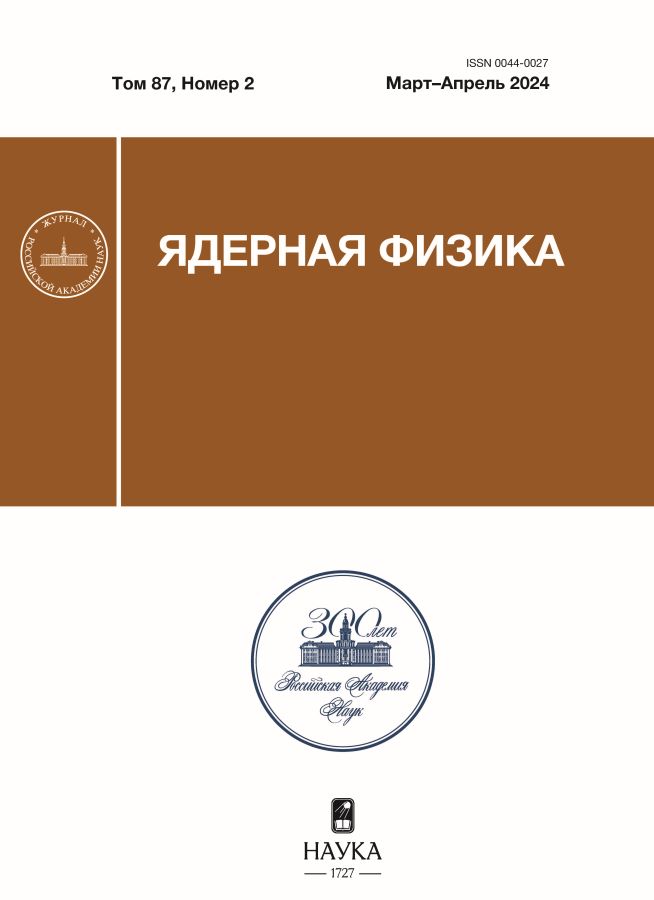Features of Forbush decreases according to satellite and ground based detectors
- Авторлар: Lagoida I.A.1, Voronov S.A.1, Mikhailov V.V.1
-
Мекемелер:
- National Research Nuclear University ‟MEPhI” (Moscow Engineering Physics Institute)
- Шығарылым: Том 87, № 2 (2024)
- Беттер: 86-90
- Бөлім: ЭЛЕМЕНТАРНЫЕ ЧАСТИЦЫ И ПОЛЯ. Эксперимент
- ##submission.datePublished##: 07.10.2024
- URL: https://cardiosomatics.ru/0044-0027/article/view/674660
- DOI: https://doi.org/10.31857/S0044002724020036
- EDN: https://elibrary.ru/KRVVZK
- ID: 674660
Дәйексөз келтіру
Аннотация
Forbush decreases are sudden drops of cosmic ray intensity recorded by ground based and satellite detectors. This effect is strongly connected with coronal mass ejections from the Sun. Those are the massive eruptions of plasma material from the Sun atmosphere into interplanetary space. Coronal mass ejections affect cosmic ray particles while moving through interplanetary space causing Forbush decrease. In this work, we have studied the behavior of temporal profiles of cosmic ray intensity during Forbush decreases using data on cosmic proton fluxes recorded by the AMS-02 spectrometer during 2011 to 2019.
Толық мәтін
Авторлар туралы
I. Lagoida
National Research Nuclear University ‟MEPhI” (Moscow Engineering Physics Institute)
Хат алмасуға жауапты Автор.
Email: IALagoida@mephi.ru
Ресей, Moscow
S. Voronov
National Research Nuclear University ‟MEPhI” (Moscow Engineering Physics Institute)
Email: IALagoida@mephi.ru
Ресей, Moscow
V. Mikhailov
National Research Nuclear University ‟MEPhI” (Moscow Engineering Physics Institute)
Email: IALagoida@mephi.ru
Ресей, Moscow
Әдебиет тізімі
- S. E. Forbush, Phys. Rev. 51, 1108 (1937).
- N. Gopalswamy, Space Sci. Rev. 124, 145 (2006).
- A. V. Belov, E. A. Eroshenko, A. B. Struminsky, and V. G. Yanke, Adv. Space Res. 27, 625 (2001).
- I. G. Richardson and H. V. Cane, Sol. Phys. 270, 609 (2011).
- N. Iucci, M. Parisi, M. Storini, and G. Villoresi, Nuovo Cimento 2, 1 (1979).
- H. S. Hudson, J. L. Bougeret, and J. Burkepile, Space Sci. Rev. 123, 13 (2006).
- P. Picozza, A. M. Galper, G. Castellini, O. Andriani, F. Altamura, M. Ambriola, G. C. Barbarino, A. Basili, G. A. Bazilevskaja. R. Bencardino, M. Boezio, E. A. Bogomolov, L. Bonechi, M. Bongi, L. Bongiorno, V. Bonvicini, et al., Astropart. Phys. 27, 296 (2007).
- T. H. Zurbuchen and I. G. Richardson, Space Sci. Rev. 123, 31 (2006).
- I. G. Richardson and H. V. Cane, J. Geophys. Res. Space Phys. 100, 23397 (1995).
- H. V. Cane, Space Sci. Rev. 93, 55 (2000).
- J. A. Lockwood, Space. Sci. Rev. 12, 658 (1971).
- J. A. Lockwood, W. R. Webber, and J. R. Jokipii, J. Geophys. Res. Space Phys. 91, 2851 (1986).
- W. R. Webber, in Progress in Elementary Particle and Cosmic Ray Physics, Ed. by J. G. Wilson and S. A. Wouthuysen (North-Holland, Amsterdam, 1962), p. 75.
- G. Wibberenz, J. A. Le Roux, M. S. Potgieter, and J. W. Bieber, Space Sci. Rev. 83, 309 (1998).
- I. G. Usoskin, I. Braun, O. G. Gladysheva, J. R. Horandel, T. Jamsen, G. A. Kovaltsov, and S. A. Starodubsev, J. Geophys. Res. 113, A07102 (2008).
- L. Zhao and L. Zhang. Astrophys. J. 827, 13 (2016).
- R. Munini, M. Boezio, A. Bruno, E. C. Christian, G. A. de Nolfi, V. Di Felice, M. Martucci, M. Merge, I. G. Richardson, J. M. Ryan, S. Stochaj, O. Adriani, G. C. Barbarino, G. A. Bazilevskaya, R. Bellotti, M. Bongi, et al., Astrophys. J. 853, 11 (2018).
- F. Alemanno, Qi An, P. Azzarello, F. C. T. Barbato, P. Bernardini, B. XiaoJun, M. Cai, E. Casilli, E. Catanzani, J. Chang, D. Chen, J. Chen, Z. Chen, M. Cui, T. Cui, Y. Cui, et al., Astrophys. J. Lett. 920, L43 (2021).
- I. A. Lagoida, S. A. Voronov, V. V. Mikhailov, M. Boezio, R. Munini, C. Gustavino, G. A. Bazilevskaya, R. Belloti, E. A. Bogomolov, V. Bonvicini, F. Cafanga, D. Campana, M. Casolino, A. M. Galper, S. Koldobskiy, A. N. Kvashnin, et al., Sol. Phys. 298, 9 (2023).
- M. Aguilar, L. Ali Cavasonza, G. Ambrosi, L. Arruda, N. Attig, F. Barao, L. Barrin, A. Bartoloni, J. Bates, R. Battiston, M. Behlmann, B. Beischer, J. Berdugo, B. Bertucci, V. Bindi, W. de Boer, et al., Phys. Rev. Lett. 127, 271102 (2021).
- V. Domingo, B. Fleck, and A. I. Poland, Space Sci. Rev. 72, 81 (1995).
- K. W. Ogilvie and M. D. Desch, Adv. Space Res. 20, 559 (1997).
Қосымша файлдар













